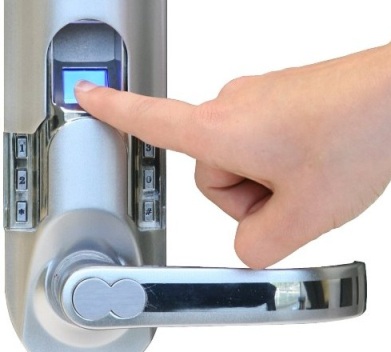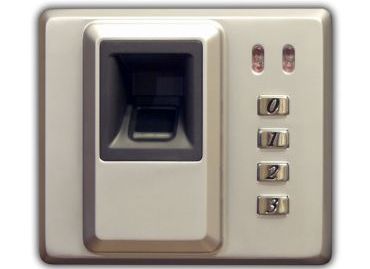Categories: How does it work
Number of views: 7455
Comments on the article: 1
Biometric locks - device, principle of operation, varieties
General information and the principle of operation of the biometric lock
Electronic locks are increasingly becoming part of the life of a modern person. The number of varieties of electronic locks is very large, and mechanical ones are gradually replaced by them. Recently, biometric locks have appeared on the horizon, about which something is already known, and they will be discussed in this article.
What is biometrics in general? It all starts with the fact that for authenticating a person, the owner of an apartment, house or safe, you can use individual information, the source of which is DNA: a picture of a fingerprint or iris, an image of the retina or veins on the front of the eye - these are individual keys, which can be used as such for opening and closing a biometric lock, because there are no people with the same DNA in the world.

The biometric lock electronics will analyze the fingerprint pattern, compare it with its user base, and open the door if it matches. Initially, family members simply write their fingerprints to the database of the biometric lock, and then they become entitled to use the biometric lock unhindered for themselves.
Identification systems in computers and smartphones that have biometric access protection work exactly the same way: a person swipes a finger over the sensor, and the lock is released. This provides a high degree of protection.
A biometric lock makes life easier for its owner, who no longer needs to carry a bunch of keys with him and try to find a keyhole in the darkness of the entrance, just put your finger on the illuminated sensor.
The operation of the lock is maintained at high temperatures, and the bolt control mechanism is quite reliable and durable. Power is supplied from batteries, when discharged, a signal will be given indicating the need to replace them. As an additional protection, a digital code or a special key is provided for unforeseen situations.

The concept of biometric protection minimizes the likelihood of error. Codes are compared with exact electronics, and only when they exactly match the crossbars move, unlocking the door. The idea is similar to how an ordinary key works, when cylinders and discs must exactly match, but here the degree of accuracy is thousands of times higher, since biometric structures are much more complicated than typical metal key structures.
Of course, in rare cases, a fingerprint may not be accepted, for example, if there is a wound or dirt on the finger, but several fingers can be memorized, then the likelihood of misunderstandings will decrease. False responses to someone else’s fingerprint are also possible in principle, but the probability of such an outcome for modern biometric locks is vanishingly small.
The criteria for assessing the quality of biometric locks are as follows: FRR (False Rejection Rate) - the probability of not accepting the correct fingerprint; FAR (False Acceptance Rate) - the probability of accepting someone else's fingerprint as your own. These parameters are usually fractions of a percent, and FRR is an order of magnitude higher than FAR.
So, for Samsung locks - FRR 0.01% and FAR 0.001%, and for Gateman locks - FAR - 0.0000014%, and FRR - 2.1%. Obviously, with a much greater probability, the castle will refuse to its owner, who just has to put his finger again than let a stranger into the house.
The device of biometric locks and their types
The biometric lock can be divided into three parts: external, internal, and a battery compartment. The external part contains a biometric scanner designed to identify a fingerprint, sometimes a screen and a keyboard can also be located here.Inside, i.e. inside microcontroller located with a memory function, where the fingerprints of those to whom the lock opens are stored. The batteries are inserted into the battery compartment.

Like conventional locks, biometric locks are mortise, overhead, handle-shaped, built-in, crossbar. Reliability is ensured mainly by the fact that it is almost impossible to break such a lock, because there are no external holes in it that an attacker could catch on or into which, like into a well, something could be shoved. The tricks here are worthless.
There are several distinctive features of a biometric castle. The lock is equipped with night lights, and if the door is not closed tightly, the alarm will sound (light, sound). In the event of an attempted entry, an alarm will also be triggered. If the battery needs to be replaced, the alarm will sound again. From the inside, the door can be opened with the remote control.
Features of biometric locks
Of course, there are no doubts about the reliability of biometric locks, compared to traditional ones, and biometric locks can have additional sensors, for example, infrared and electron-optical sensors for safes, operating in a wide frequency range, increase security by several times. In this case, up to 100 prints can be entered into the database.

The castle is essentially a security system, and there is the possibility of joint operation of the castle system with video cameras. Alarms about a fire, about an attempt to hack, the inclusion of video, in order to remove the intruder when trying to open a safe, for example. The security mode can lock the lock in case of fixing an attempt to break in, then the safe or the door will be impossible to open without special means. And the functionality of such a plan is constantly expanding. For all this, the size of the biometric lock does not differ from the usual one.
Special requirements apply to the installation of a biometric lock. The crossbars are installed around the entire perimeter of the door. The control module is installed inside the web. Posting is made so that it is difficult to detect. That is, installation should be done exclusively by specialists.
To insert the lock, a large hole is cut out, where the actuator is installed. Then make another hole where the control unit is installed. The layout must be very, very accurate, because the smallest deviation will lead to incorrect operation of the system, therefore, when installing a biometric lock, double-sided stencils are always used.

Upon completion of installation, the internal lock system is connected to the mechanisms, for this flexible wiring is used. The terminals reliably connect and protect against moisture. The possibility of contact of the electronics with the internal parts and with the metal elements of the door is excluded.
See also at bgv.electricianexp.com
:
